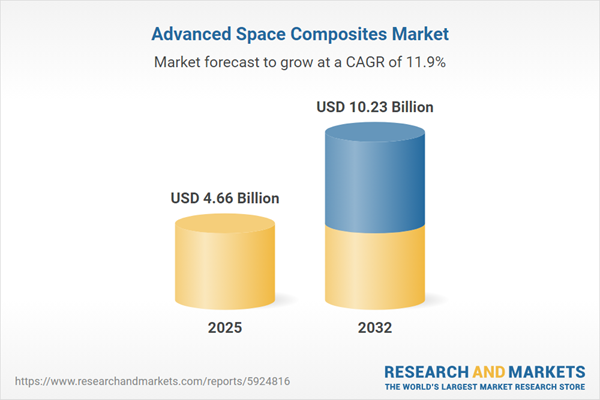Speak directly to the analyst to clarify any post sales queries you may have.
The advanced space composites market is rapidly redefining the standards of aerospace performance, enabling the design, manufacture, and deployment of next-generation spacecraft, satellites, and launch systems. As end-users demand solutions that balance structural efficiency, thermal resilience, and lightweight construction, innovative composite materials continue to play a vital strategic role in global space programs.
Market Snapshot: Advanced Space Composites Landscape
The Advanced Space Composites Market grew from USD 4.16 billion in 2024 to USD 4.66 billion in 2025. It is expected to continue growing at a CAGR of 11.88%, reaching USD 10.23 billion by 2032. Expansion is driven by increasing investment in deep space missions, the rise of satellite megaconstellations, mainstream adoption of small launch vehicles, and the push for improved manufacturing scalability. Strategic supply chain adaptations and advances in material science are underpinning robust demand across regions and applications.
Scope & Segmentation of the Advanced Space Composites Market
This report offers an in-depth analysis of the market’s core segments and regional insights, providing stakeholders with actionable intelligence:
- Fiber Types: Aramid, Carbon, Glass
- Resin Types: Epoxy, Phenolic, Polyester, Thermoplastics (including PEEK, PEI, PPS), Vinyl Ester
- End-Use Industries: Aerospace & Defense (Commercial, Military, Space), Automotive (Commercial & Passenger Vehicles), Construction & Infrastructure (Bridges, Buildings), Marine (Commercial Ships, Pleasure Crafts), Sports & Leisure (Apparel, Equipment, Footwear), Wind Energy (Blades, Nacelles, Towers)
- Product Forms: Bulk Molding Compound, Filament Wound Products, Prepreg, Pultruded Profiles, Sheet Molding Compound
- Manufacturing Processes: Autoclave Process, Compression Molding, Filament Winding, Hand Layup, Out-Of-Autoclave, Resin Transfer Molding (SCRIMP, Standard RTM, VARTM), Vacuum Infusion
- Regions: Americas (North America: United States, Canada, Mexico; Latin America: Brazil, Argentina, Chile, Colombia, Peru), Europe, Middle East & Africa (Europe: United Kingdom, Germany, France, Russia, Italy, Spain, Netherlands, Sweden, Poland, Switzerland; Middle East: United Arab Emirates, Saudi Arabia, Qatar, Turkey, Israel; Africa: South Africa, Nigeria, Egypt, Kenya), Asia-Pacific (China, India, Japan, Australia, South Korea, Indonesia, Thailand, Malaysia, Singapore, Taiwan)
- Leading Companies: Toray Industries, Inc.; Hexcel Corporation; Solvay S.A.; SGL Carbon SE; Teijin Limited; Mitsubishi Chemical Corporation; Gurit Holding AG; Huntsman Corporation; Arkema S.A.; DuPont de Nemours, Inc.
Key Takeaways: Strategic Insights for Senior Decision-Makers
- Innovation in fiber and resin chemistries is enabling composites that meet demanding requirements for thermal stability, fatigue resistance, and impact protection.
- Automated and additive manufacturing processes are restructuring production workflows, reducing costs and compressing lead times for mission-critical aerospace components.
- Sustainability is influencing product development, with circular economy principles guiding advancements in recyclable thermoplastics and bio-based resins for lifecycle management.
- Strategic alliances between suppliers, fabricators, and launch service providers are accelerating material qualification and integrating new composites into subsystem design at pace.
- Region-specific trends are creating opportunities in satellite expansion, reusable vehicle platforms, and cost-optimized manufacturing across established and emerging space markets.
- Digital technologies, including digital twins and machine learning, support real-time performance prediction and certification process optimization.
Tariff Impact on Supply Chain and Market Strategy
Recent tariff adjustments in the United States have led manufacturers to realign sourcing and production strategies. Increased duties on essential raw materials have driven diversification of supplier bases, new domestic and international partnerships, and greater vertical integration among leading composite fabricators. Manufacturers have intensified efforts to explore alternative fiber architectures and thermoplastic solutions to maintain competitive cost structures and ensure resilient supply chains.
Methodology & Data Sources
Findings are based on primary interviews with composites experts, space system integrators, material suppliers, and regulatory stakeholders. Comprehensive review of technical papers, institutional research, industry specifications, and patent data supports secondary insights. Analytical rigor is maintained through peer review, triangulation of sources, benchmarking, scenario analysis, and structured expert validation processes.
Why This Report Matters
- Offers a strategic view of emerging technologies, shifting supply chains, and regulatory considerations shaping the advanced space composites sector.
- Enables leaders to optimize investment, accelerate technology adoption, and maintain a competitive edge in rapidly evolving end-use markets.
- Provides actionable recommendations for risk mitigation, collaboration, and sustainable product development tailored to market needs.
Conclusion
The advanced space composites market is progressing toward new frontiers in efficiency, sustainability, and collaborative innovation. Stakeholders aligning technological investment and supply resilience with evolving industry trends will capture substantial value from future growth opportunities.
Additional Product Information:
- Purchase of this report includes 1 year online access with quarterly updates.
- This report can be updated on request. Please contact our Customer Experience team using the Ask a Question widget on our website.
Table of Contents
3. Executive Summary
4. Market Overview
7. Cumulative Impact of Artificial Intelligence 2025
Companies Mentioned
The companies profiled in this Advanced Space Composites market report include:- Toray Industries, Inc.
- Hexcel Corporation
- Solvay S.A.
- SGL Carbon SE
- Teijin Limited
- Mitsubishi Chemical Corporation
- Gurit Holding AG
- Huntsman Corporation
- Arkema S.A.
- DuPont de Nemours, Inc.
Table Information
| Report Attribute | Details |
|---|---|
| No. of Pages | 191 |
| Published | October 2025 |
| Forecast Period | 2025 - 2032 |
| Estimated Market Value ( USD | $ 4.66 Billion |
| Forecasted Market Value ( USD | $ 10.23 Billion |
| Compound Annual Growth Rate | 11.8% |
| Regions Covered | Global |
| No. of Companies Mentioned | 11 |









